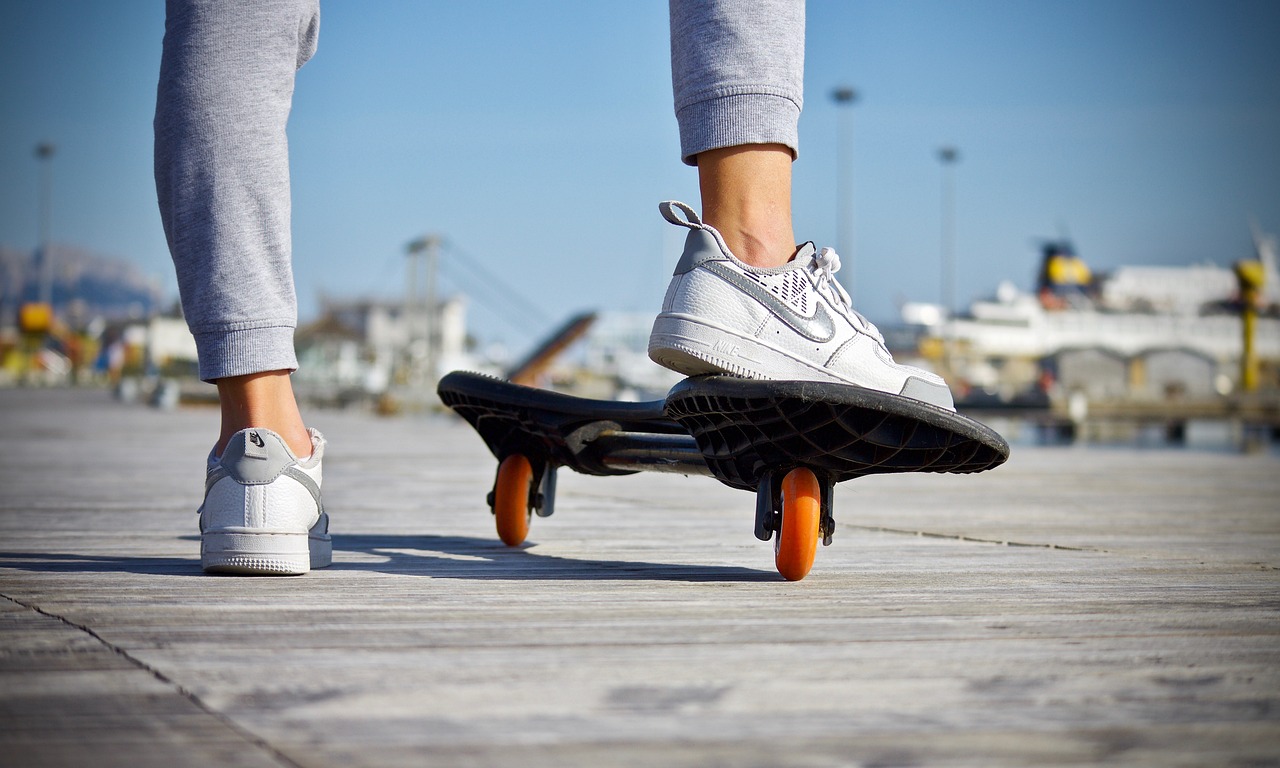Unleashing the Freedom: How Skateboards Became a Symbol of Rebellion

In the vibrant tapestry of the 1960s, a new form of expression emerged from the streets, one that would capture the essence of youth rebellion and freedom. Skateboarding, once a simple pastime, transformed into a powerful symbol of defiance and individuality. Let’s explore how skateboards became synonymous with the revolutionary spirit of the era.
The Birth of a Movement
Skateboarding began as an offshoot of surfing culture, with surfers seeking a way to enjoy their passion on land. But as it evolved, it became much more:
- A Tool for Freedom: Young people found an exhilarating way to express themselves and escape societal constraints.
- A Community Builder: Skateboarding brought together diverse groups, fostering friendships and a sense of belonging.
- A Canvas for Creativity: Custom boards and tricks became a form of artistic expression.
Skateboards and Rebellion
The skateboard became a vehicle for rebellion against cultural norms. Here are some key aspects of this transformation:
- Challenging Authority: Skateboarding often took place in unconventional spaces, such as empty swimming pools and urban landscapes, challenging the status quo.
- Fashion Statement: Skateboarders adopted unique styles that set them apart, from baggy pants to graphic tees, reflecting their individuality.
- Music and Culture: The rise of punk rock and surf music intertwined with skate culture, amplifying its rebellious nature.
Interactive Reflection
Let’s take a moment to reflect on the impact of skateboarding. Ask yourself:
- What does freedom mean to you?
- Can you recall a time when you challenged the norms in your own life?
Legacy of the Skateboard
Even today, skateboarding remains a powerful symbol of freedom and rebellion. As we look back at the 1960s, we can see how this simple wooden board became a force for change:
- Inspiring Generations: Skateboarding continues to inspire young people to embrace their uniqueness.
- Cultural Influence: It has influenced art, music, and fashion, leaving an indelible mark on society.
- A Global Movement: What began in California has spread worldwide, uniting diverse cultures through a shared passion.
The spirit of the 1960s lives on in the skateboard, a testament to the power of youthful rebellion and the quest for freedom. As we reminisce about this era, let’s celebrate the skateboard not just as a toy, but as a symbol of creativity, community, and defiance against conformity.
From Sidewalks to Streets: The Evolution of Skateboard Culture in the 1960s

Introduction to Skateboard Culture
Skateboarding in the 1960s was not just a pastime; it was a cultural revolution that reshaped the way young people interacted with their environment. Imagine children and teenagers transforming ordinary sidewalks into dynamic playgrounds, where creativity knew no bounds. This period marked the transition of skateboarding from a simple activity to a vibrant subculture.
The Birth of the Skateboard
Initially, skateboards were made from simple materials. Do you remember the first time you saw a skateboard? It was often a wooden board with roller skate wheels attached. These early boards were referred to as sidewalk surfboards, mimicking the motions of surfing but on land. The thrill of riding these boards on the smooth concrete of sidewalks brought joy and freedom to many.
Popularization and the Rise of Skate Parks
By the mid-1960s, skateboarding began to gain traction. Skate parks started popping up, providing dedicated spaces for skaters to hone their skills. Do you remember the excitement of seeing a group of kids gathering at a local skate park? It was a melting pot of creativity, where skaters could share tips, tricks, and camaraderie.
Skateboarding Goes Mainstream
As skateboarding grew in popularity, it caught the attention of the media. Magazines began featuring articles on skateboarding tricks, and television shows showcased talented skaters. This newfound visibility helped to establish skateboarding as a legitimate sport. Can you recall any iconic skaters from that era?
Fashion and Identity
Skateboarding was more than just a sport; it became a means of self-expression. Skaters adopted unique styles, often wearing baggy pants and graphic tees, which set them apart from mainstream fashion. Do you remember how a skater’s outfit could speak volumes about their personality?
Community and Belonging
The skateboard community thrived on the principles of inclusivity and support. It was common to see skaters cheering each other on, whether they were attempting to land a new trick or simply enjoying a ride. The bonds formed during these shared experiences were profound. Did you have any friends who were part of this vibrant community?
Conclusion: The Legacy of 1960s Skateboarding
The 1960s laid the groundwork for what skateboarding would become in the following decades. The spirit of innovation, freedom, and community that emerged during this era continues to influence skateboard culture today. As we reflect on this transformative decade, it’s important to appreciate the joy and creativity that skateboarding brought to so many lives.
We invite you to share your memories of skateboarding or how it impacted your community. Did you or someone you know have a skateboard? What were the most memorable experiences? Your stories are an important part of preserving this cultural legacy.
Wheels of Change: The Impact of Skateboarding on Youth Identity

Introduction to Skateboarding’s Cultural Shift
In the 1960s, a new form of expression began to emerge among the youth—skateboarding. This seemingly simple activity of riding on wooden planks with wheels transformed into a vibrant culture that reshaped identities and social interactions. Let’s explore how skateboarding acted as a catalyst for change in youth identity during this revolutionary decade.
The Birth of Skateboarding
Skateboarding originated in California as surfers sought a way to mimic the ocean’s waves on land. What began as a pastime quickly evolved into a full-fledged movement:
- Innovative Designs: Early skateboards were made from wooden boxes with roller skate wheels.
- Emerging Techniques: Youth began developing tricks and styles that showcased their creativity.
Skateboarding as a Form of Identity
For many young people, skateboarding became more than just a sport; it was a way to express individuality:
- Subcultures: Skateboarding gave rise to various subcultures that fostered community and belonging.
- Fashion Statements: Skateboarders created unique styles that influenced fashion trends.
Challenging Social Norms
As skateboarding gained popularity, it also began to challenge societal expectations:
- Breaking Barriers: Skateboarding was inclusive, attracting youth from diverse backgrounds.
- Defying Authority: Skateboarders often pushed back against regulations and norms, asserting their independence.
The Influence of Media
The role of media in shaping skateboarding culture cannot be overstated:
- Magazines and Documentaries: Publications like Thrasher showcased skateboarders, inspiring new generations.
- Movies: Films like Dogtown and Z-Boys highlighted the lifestyle and struggles of skateboarders.
Skateboarding and Community Building
Skateboarding fostered a sense of community among its enthusiasts:
- Skate Parks: The creation of skate parks provided safe spaces for youth to gather and hone their skills.
- Events and Competitions: Competitions helped build camaraderie and a sense of belonging.
Legacy of the 1960s Skateboarding Revolution
The impact of skateboarding in the 1960s has lasting effects:
- Ongoing Influence: The spirit of skateboarding continues to inspire youth today.
- Cultural Integration: Elements of skate culture have been absorbed into mainstream culture, from music to fashion.
Conclusion: Reflecting on the Changes
The revolution of skateboarding in the 1960s was not merely about the sport but about shaping identities and fostering community among youth. It challenged societal norms and provided a platform for self-expression, leaving a legacy that continues to influence generations. As we reflect on this transformative era, we recognize the profound impact that skateboarding had and still has on youth identity.
Cruising Through History: Iconic Skateboards of the 1960s
Introduction to 1960s Skateboarding
The 1960s was a decade of change, not just in music and fashion, but also in the world of sports and recreation. One of the most iconic symbols of this era was the skateboard. Let’s take a journey back in time to explore the evolution of skateboards that shaped this revolutionary spirit.
In the early 1960s, skateboarding emerged as a popular pastime for kids and teenagers. Originally made from wooden boxes or planks with roller skate wheels attached, these early skateboards were basic yet innovative. Can you remember the thrill of gliding down the street?
Iconic Skateboards of the 1960s
| Skateboard | Year Released | Features |
|---|---|---|
| Makaha Skateboard | 1965 | One of the first commercial skateboards, featuring a wooden deck and clay wheels. |
| Logan Earth Ski | 1965 | Longer and wider than most, it was perfect for downhill rides. |
| Fiberflex Skateboard | 1967 | Introduced flex technology, allowing better maneuverability. |
| G&S Fiberflex | 1968 | Known for its colorful designs and fiberglass construction. |
The Cultural Impact of Skateboarding
Skateboarding was not just a sport; it became a cultural phenomenon. It integrated music, fashion, and a sense of freedom. The rebellious spirit of youth found a voice through skateboarding. Do you recall the music that accompanied your skating adventures?
Skateboarding and the Rise of Competitions
By the late 1960s, skateboarding competitions began emerging, showcasing talent and creativity. The National Skateboarding Championships was one such event that brought together the best skaters. Can you envision the excitement of watching these competitions?
Conclusion: The Legacy of 1960s Skateboards
The skateboards of the 1960s laid the foundation for the modern skateboarding culture we see today. They symbolize a time of innovation and freedom. What memories do you have of skateboarding in your youth? Share your stories and let’s reminisce together!
The Art of Balance: Exploring the Skill and Creativity Behind Skateboarding
Have you ever watched a skateboarder glide effortlessly down the street, performing tricks that seem to defy gravity? Skateboarding is not just a sport; it is an exquisite dance of balance, skill, and creativity. Let’s dive into the elements that make skateboarding an art form.
The Importance of Balance
Balance is the cornerstone of skateboarding. It requires not only physical stability but also mental focus. As you stand on a skateboard, your body must adjust to shifts in weight and momentum. This leads to a deeper understanding of your body and its capabilities.
Skills Required for Skateboarding
| Skill | Description |
|---|---|
| Pushing Off | The basic movement of starting to ride. It involves using one foot to push against the ground while the other remains on the board. |
| Turning | Shifting weight to change direction. This can be done by leaning or using the board’s tail to pivot. |
| Stopping | Using various techniques, such as foot braking or dragging, to come to a halt safely. |
| Tricks | Advanced maneuvers that showcase creativity, like ollies, kickflips, and grinds. |
Creativity in Skateboarding
Skateboarding is a canvas for self-expression. Skateboarders often personalize their boards with unique designs and artwork, reflecting their individuality. Additionally, the way they perform tricks can be a form of storytelling, communicating their feelings and experiences through movement.
Engaging with the Skateboarding Community
For those interested in skateboarding, joining a local community can enhance your experience. Many skate parks offer lessons for beginners and opportunities to connect with others who share your passion. You may discover that skateboarding fosters friendships and a sense of belonging.
Skateboarding beautifully combines skill, balance, and creativity. It is not just about riding a board; it is about embracing a lifestyle that encourages self-expression and community. Whether you’re reminiscing about the past or considering a new hobby, skateboarding offers a unique perspective on the art of balance.
Legends on Wheels: Profiles of 1960s Skateboarding Pioneers
Introduction to the Pioneers
In the vibrant culture of the 1960s, a new form of self-expression emerged on the streets: skateboarding. The pioneers of this thrilling sport not only shaped skateboarding but also influenced an entire generation’s attitude towards freedom and rebellion. Let’s dive into the lives of these remarkable individuals who became legends on wheels.
1. Tony Alva
Biography: Born in 1957, Tony Alva was a prodigy who took skateboarding to new heights. He was known for his aggressive style and innovative tricks.
Contribution: Alva was one of the first skateboarders to perform tricks in empty swimming pools, which revolutionized the sport. His fearless attitude and creativity made him a role model.
2. Stacey Peralta
Biography: A key figure in the skateboarding scene, Stacey Peralta was not just a skateboarder but also a filmmaker and entrepreneur.
Contribution: He co-founded the Z-Boys skate team and later created the documentary “Dogtown and Z-Boys,” showcasing the culture of skateboarding.
3. Jay Adams
Biography: Born in 1961, Jay Adams was known for his natural talent and laid-back style.
Contribution: Adams helped pioneer the modern skateboard trick, becoming a legend in the sport and inspiring countless skaters.
4. Bob Biniak
Biography: Bob Biniak was one of the first skateboarders to gain national attention for his freestyle skating.
Contribution: His smooth style and technical skills set a new standard for freestyle competitions.
5. Peggy Oki
Biography: As one of the few female pioneers in the 1960s skateboarding scene, Peggy Oki broke gender barriers.
Contribution: Oki was a talented skateboarder and an influential figure in promoting inclusivity in the sport.
6. Alan Gelfand
Biography: Known as “Ollie,” Alan Gelfand was instrumental in developing one of the most famous skateboarding tricks.
Contribution: The “Ollie” trick became a foundational move in skateboarding, allowing for more complex maneuvers.
The legends of 1960s skateboarding not only transformed the sport but also left a lasting legacy that continues to inspire new generations. Their daring spirit and creativity on wheels paved the way for the modern skate culture we see today. Whether you were a part of this era or are discovering it now, these pioneers remind us of the joy and freedom that skateboarding can bring.
Beyond the Board: The Social Revolution Sparked by Skateboarding
Understanding the Roots of Skateboarding
Skateboarding, which emerged as a popular activity in the 1960s, was more than just a sport; it became a cultural phenomenon. Picture yourself in California during the summer of ’66. The streets were vibrant with teens cruising on their boards, embodying a sense of freedom and rebellion against societal norms.
A Symbol of Freedom and Expression
As skateboarding gained traction, it evolved into a platform for self-expression. Young people began to decorate their boards with colorful designs and stickers, showcasing their individuality. Can you imagine how this simple act of personalization was a reflection of the broader counterculture movement of the time?
Building Communities on Wheels
Skateboarding also fostered a sense of community. Local skate spots became gathering places where friendships were formed, regardless of background or social class. Think about how these interactions broke down barriers and encouraged unity among diverse groups of people.
The Influence of Music and Art
The 1960s were also a significant era for music and art, and skateboarding was deeply intertwined with both. The sounds of surf rock and the vibrant art styles of the time influenced skateboard culture. Can you recall how music could evoke memories and feelings from your youth? Skateboarding had its own soundtrack, shaping the riders’ experiences.
Women in Skateboarding
While often overshadowed, women played a crucial role in the skateboarding scene. As they took to the streets, they challenged traditional gender roles and showcased their skills. Imagine the empowerment they felt as they skated alongside their male counterparts, proving that skateboarding was for everyone.
The Legacy and Lasting Impact
The 1960s laid the groundwork for what skateboarding would become in the decades that followed. Its revolutionary spirit inspired future generations to embrace creativity, community, and individuality. Even today, as you observe the evolution of skateboarding, can you see its roots in the cultural shifts of the past?
Engagement: Reflecting on the Past
As you reflect on this era, consider how the spirit of skateboarding resonated with the societal changes of the 1960s. What memories do you have that relate to the freedom of movement, collective gatherings, or the art and music that defined your youth? Share your thoughts!
Skateboarding in the Spotlight: How Media Shaped Public Perception
Introduction to Skateboarding’s Rise
In the 1960s, a new culture began to emerge, and skateboarding was at the forefront. This was more than just a pastime; it was a revolutionary movement that captured the hearts of many, especially the youth. With skateboards becoming more popular, the media played a crucial role in shaping public perception. Let’s take a closer look at how the media influenced this exciting new sport.
The Birth of Skateboarding in Media
Initially, skateboarding was viewed as a fringe activity, often associated with rebellious youth. However, as coverage increased, so did the interest. Television shows and magazines started featuring skateboarding, showcasing not just the tricks but also the lifestyle that accompanied it. Can you remember the first time you saw a skateboard on TV? It was hard to ignore!
Television and Film: A Game Changer
Films like The Endless Summer and television programs such as Wide World of Sports introduced skateboarding to a broader audience. These platforms highlighted the thrill and excitement of the sport, making it appealing to many. Do you recall watching those iconic moments on screen? They brought skateboarding to life!
Magazines and Print Media
Magazines such as Skateboarder and Surfing played a vital role in the skateboarding community. They showcased not just the latest tricks but also the stories of the skaters. This helped in building a community and a sense of belonging. Have you ever flipped through one of those magazines, feeling inspired by the stories and visuals?
Changing Public Perception
As skateboarding gained popularity, public perception began to shift. It was no longer seen merely as a rebellious activity but rather as a legitimate sport. The media’s portrayal helped to legitimize skateboarding, encouraging participation from diverse age groups. Isn’t it fascinating how media can change our views?
The Impact of Advertising
Advertising also played a role in shaping perceptions. Companies began to market skateboards as must-have items, often associating them with freedom and creativity. This advertising pushed skateboarding into the mainstream, turning it into a cultural phenomenon. Can you think of any memorable advertisements that stood out to you?
The media’s influence on skateboarding in the 1960s was profound. It transformed how society viewed the sport, paving the way for future generations. Today, skateboarding is celebrated worldwide, and it all began with a little coverage that sparked a revolution. Reflecting on this, what do you think was the most significant impact of media on skateboarding?
The Community Spirit: Bonding Through Skateboarding in a Turbulent Era
The Rise of Skateboarding Culture
In the 1960s, skateboarding emerged as more than just a hobby; it became a cultural phenomenon. Imagine a time when the streets were filled with young individuals, their skateboards gliding over pavement, united by a common passion. Can you recall the thrill of those days?
Skateboarding as a Form of Expression
During a decade marked by social upheaval, skateboarding offered a unique avenue for self-expression. It was a way for the youth to break away from traditional norms and challenge the status quo. Each trick performed was a statement, a form of rebellion. How did you express yourself during turbulent times?
The Formation of Skateboarding Communities
As skateboarding gained popularity, local communities began to form. Skate parks and empty lots became gathering places where friendships blossomed. These spaces were filled with laughter, camaraderie, and the sound of wheels on concrete. Did you ever spend time in such a community?
Shared Experiences and Lifelong Bonds
Skateboarding created lasting memories. From learning to ride to mastering tricks, each challenge was met collectively. These shared experiences fostered a sense of belonging that transcended backgrounds. Can you recall a moment when you bonded with others over a shared passion?
The skateboarding culture of the 1960s was intricately linked to the music and art of the era. From the vibrant graffiti on skateboards to the rock and roll beats that fueled their rides, creativity was everywhere. What music inspired you during those days?
Lasting Impact on Future Generations
Today, the spirit of the 1960s skateboarding community can still be felt. It paved the way for future generations, encouraging them to embrace their individuality and connect with others. How do you think this spirit has evolved over the decades?
Reflection on Community Values
As we reflect on the past, it’s essential to recognize the values that skateboarding instilled in its participants: friendship, resilience, and creativity. These qualities continue to resonate today, reminding us of the importance of community in any turbulent era. What values do you cherish that were shaped by your experiences?
A Journey Through Time: The Lasting Legacy of 1960s Skateboarding
The Birth of a Culture
As we take a trip down memory lane, let’s reflect on the vibrant era of the 1960s, a time when skateboarding began to carve its place in the hearts of young enthusiasts. Imagine the sun shining brightly, the sound of wheels rolling on pavement, and the laughter of children learning to ride. Can you recall your first skateboard?
How Skateboarding Started
Initially, skateboarding was an extension of surfing, with surfers looking for a way to practice when the waves were flat. This innovation led to the creation of the first skateboards, which were simply wooden boxes with roller skate wheels. It was a humble beginning, but one that sparked a revolution.
Iconic Designs and Innovations
In the 1960s, skateboards evolved rapidly. The introduction of the polyurethane wheel in the late 1960s brought a significant change, allowing for smoother rides and better performance. Can you remember the thrill of zipping down a hill? What was your favorite spot to skate?
The Skateboarding Community
Skateboarding was not just a sport; it was a community. Local skate parks began to emerge, and skateboarding clubs formed, fostering camaraderie among skaters. This sense of belonging was crucial. Did you have friends who skated with you? Share your favorite memories!
Influential Figures
Among the pioneers of this culture were figures like Tony Alva and Jay Adams, who pushed the boundaries of what skateboarding could be. Their creativity influenced many and set the stage for the sport’s future. Who inspired you during your skating days?
Challenges Faced
Despite its growing popularity, skateboarding faced challenges, including safety concerns and societal backlash. Many viewed it as a reckless activity. Did you ever encounter opposition while pursuing your passion?
The Enduring Influence
Fast forward to today, and you’ll see the profound impact of 1960s skateboarding on modern culture. The tricks, styles, and community spirit continue to thrive. Skateboarding has evolved into a multi-billion dollar industry and is even included in the Olympics! How do you feel about the current state of skateboarding?
Reflecting on the Past
As we reminisce about the 1960s skateboarding scene, it’s essential to recognize its role in shaping youth culture and promoting creativity and resilience. This legacy continues to inspire new generations of skaters. What lasting lessons did skateboarding teach you?
Join the Conversation
We would love to hear your stories and experiences from the 1960s skateboarding era. What was your favorite skateboard? Did you have any memorable rides or tricks? Let’s celebrate the legacy together!
